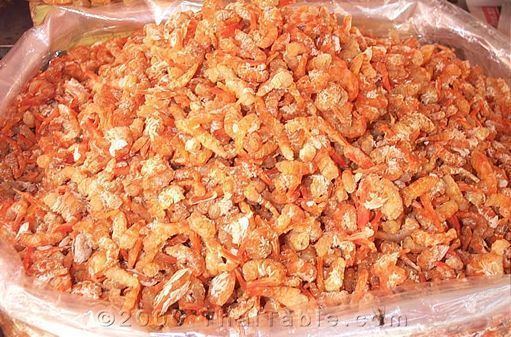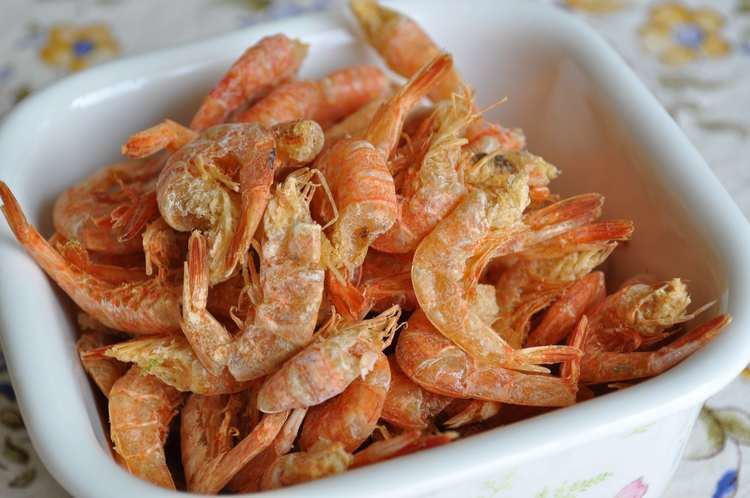Traditional Chinese 蝦米 Hanyu Pinyin | Simplified Chinese 虾米 Cantonese Yale hā máih Hanyu Pinyin | |
 | ||
Similar Shrimp paste, Shrimp and prawn as food, Sambal, Fish sauce, Bumbu | ||
How to make sun dried shrimp homemade
Dried shrimp are shrimp that have been sun-dried and shrunk to a thumbnail size. They are used in many Asian cuisines, imparting a unique umami taste. A handful of shrimp is generally used for dishes. The flavors of this ingredient are released when allowed to simmer.
Contents
- How to make sun dried shrimp homemade
- How to prepare dried shrimp
- In East Asia
- In Southeast Asia
- In India
- In Africa
- In Mexico
- In Brazil
- United States
- References

How to prepare dried shrimp
In East Asia

In Chinese cuisine, dried shrimp are used quite frequently for their sweet and unique flavor that is very different from fresh shrimp. They have the coveted umami flavor (or so-called "fifth taste"). It is an ingredient in the Cantonese XO sauce. Dried shrimp are also used in Chinese (mostly Cantonese) soups and braised dishes. It is also featured in Cantonese cuisine, particularly in some dim sum dishes such as rolled and rice noodle roll and in zongzi. Despite the literal meaning of the name Chinese name xiā mǐ ("shrimp rice"), it has nothing to do with rice other than the fact that the shrimp are shrunk to a tiny size similar to grains of rice.

Dried shrimp are also used in Korean cuisine, where they are soaked briefly to reconstitute them, and are then stir-fried with seasonings—typically garlic, ginger, scallions, soy sauce, sugar, and hot peppers—and served as a side dish. It is called "mareunsaeu bokkeum" (hangul:마른새우볶음) in Korean. They are also used in some Korean braised dishes (jorim) and used for making broth.
In Southeast Asia

Dried shrimp are used in Vietnamese cuisine, where they are called tôm khô, and are used in soups, congee, fried rice, or as a topping on stirfries (Mì Xào) or savoury snack items. They are also commonly eaten as snacks.
The Chinese living in Malaysia, especially those of Peranakan descent, developed sambal udang kering, which uses dried shrimp. It can be served as pub food.
In Indonesia dried shrimp is called ebi, the name was derived from either Chinese Hokkian dialects "hebi" means "shrimp rice" or Japanese word "ebi" means "shrimp" (either fresh or dried). Ebi is important part of Indonesian Chinese cuisine as well as Palembang cuisine, it is used in various Chinese Indonesian stir fried vegetable dishes, such as stir fried white cabbages with ebi. In Palembang, ebi is boiled, ground and sauted, to make savoury shrimp powder sprinkled upon pempek fried fish cake. Ebi also important ingredient to make shrimp broth and cooked in coconut milk to make Mie Celor. The ebi powder often also sprinkled upon asinan or sometimes rujak.
In Burmese cuisine, dried shrimp is called bazun-chauk and is used widely in cooking, such as salads, soups and condiments. It is primarily used along the coast and coastal ethnic minorities' cuisines. Toasted whole dry shrimps are used in a wide variety of Burmese salads such as laphet (fermented tea leaves), tomato and kaffir lime salads. Shredded dried prawns are used to prepare condiments such as ngapi kyaw and balachaung kyaw. Dried shrimp is also used as stock for Burmese thin soups.
Known as kung haeng (Thai: กุ้งแห้ง) in Thai cuisine, dried shrimp is used extensively with chilies and Thai herbs to produce various types of chili paste and Thai curry paste. Dried shrimp is also used in salads such as in the Northeastern Thai som tam (green papaya salad).
In the Philippines, dried shrimp is called "hibi/hibe" (Hokkien: hê-bí) and is used like salt to season dishes as well as in soup bases such as misua.
In India
It is used in the cuisine of the Konkan & Tamil Nadu region of India. There are several varieties for e.g.:- in Tamil Nadu it is called as chenna kunni:
In Africa
It is used in many African countries like Nigeria when preparing many dishes involving vegetables, typically cooked in oil with vegetables like spinach, pepper and tomato sauce.
In Mexico
Dried shrimp is commonly found in markets all throughout Mexico and perhaps their best-known use is in the "meatballs" that accompany the traditional Christmas dish romeritos.
In Brazil
The cuisine of Brazil's northeastern region makes extensive use of dried shrimp, which they call "camarão seco". It is often reconstituted for use in stews or special hot sauces, such as in Acarajé. It may also be ground into a fine powder for use as a condiment, as on Moqueca. At times it is added directly to a dish as an edible garnish.
United States
Dried shrimp was introduced to the American South in the 18th-century colonial period, by thriving Filipino fishers in Saint Malo, which was located in present-day St. Bernard Parish, Louisiana, on the shore of Lake Borgne, until 1915.
In south Louisiana, dried shrimp are often added by Cajun cooks to gumbo, to add an intense salty flavor. They can also be eaten as a snack by themselves, and can be commonly found in snack-size portions in south Louisiana's stores.
